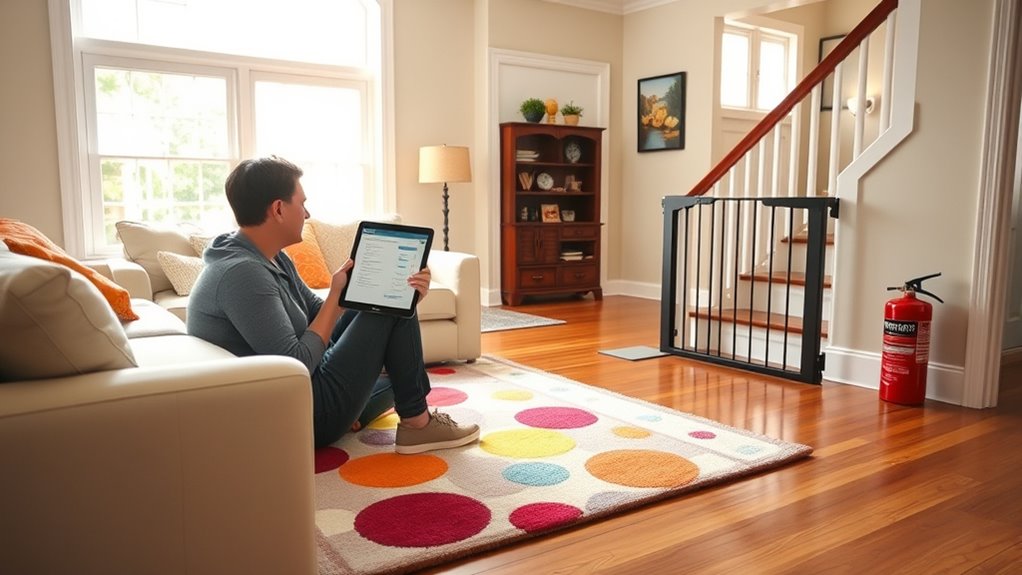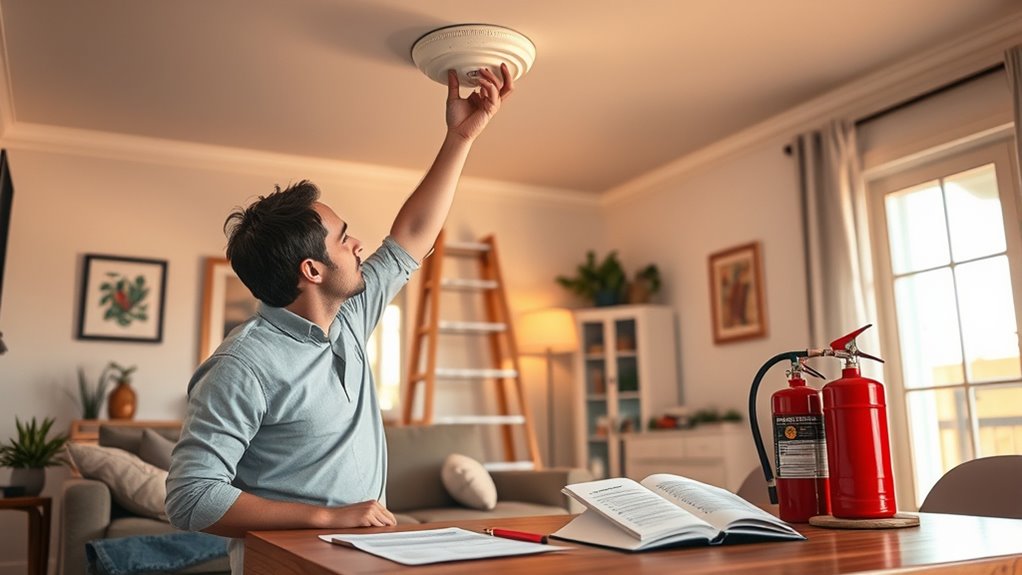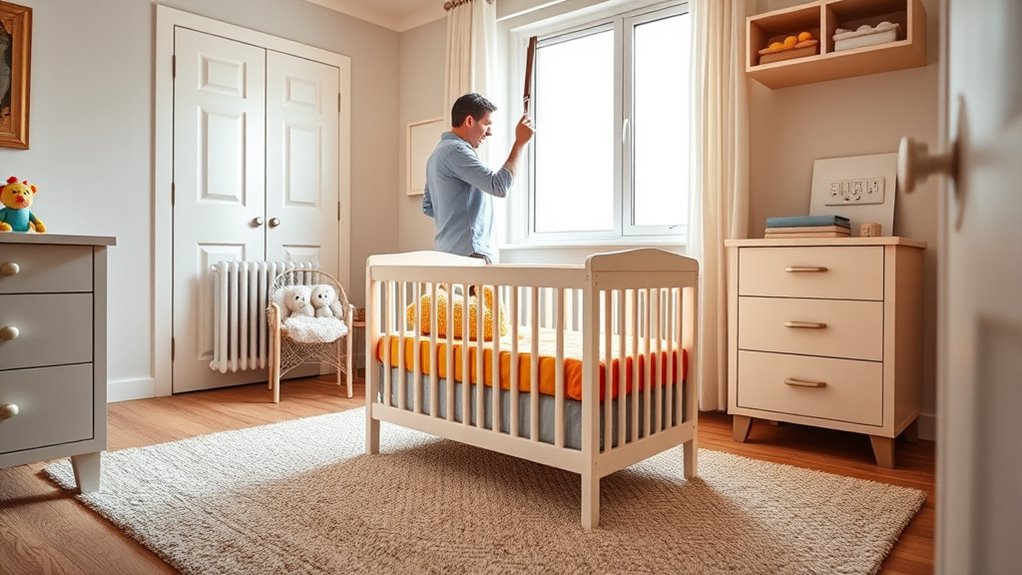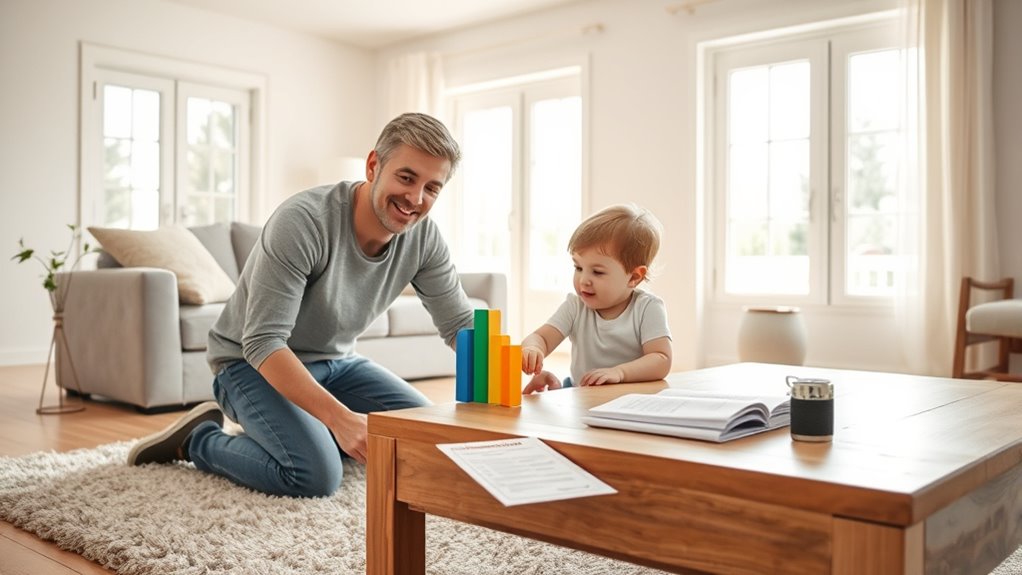To set yourself up for success with your first home safety audit, start by preparing your space—test alarms, update security devices, and clear clutter for easy access. Next, inspect hazard zones like kitchens and bathrooms, checking for electrical or structural issues. Guarantee fire safety with extinguishers and escape plans, and childproof vulnerable areas. Establish a routine for maintenance and monitoring to keep your home safe long-term. Continue exploring these steps for a thorough safety plan.
Key Takeaways
- Prepare your home by testing security systems, updating smart tech, and clearing clutter to facilitate a thorough safety inspection.
- Focus on hazard zones like kitchen, bathrooms, and basement to identify electrical, structural, and water-related risks.
- Ensure fire safety by checking extinguishers, reviewing escape routes, and practicing emergency drills with household members.
- Childproof vulnerable areas by installing safety gates, securing furniture, and keeping hazardous objects out of reach.
- Establish a routine of regular inspections and maintenance, including alarm tests, outdoor lighting checks, and system updates.
Preparing Your Home for a Safety Check

Before conducting a safety check, it’s essential to prepare your home to guarantee a thorough inspection. Start by verifying your security systems are functioning correctly—test alarms, locks, and surveillance cameras. Consider updating or upgrading your smart home technology to improve safety features, like automated lighting or remote access controls. Clear clutter from walkways and emergency exits, so inspectors can easily access key areas. Check that batteries in smoke and carbon monoxide detectors are fresh. Additionally, review your home’s digital security, verifying passwords and access controls are secure. Making these adjustments beforehand helps identify potential hazards and guarantees all safety devices operate properly. Incorporating the latest home security innovations can further enhance your safety measures. Preparing your home this way creates a solid foundation for a comprehensive safety audit, giving you peace of mind knowing your home is as safe as possible.
Inspecting Common Hazard Zones

Inspecting common hazard zones is a critical step in guaranteeing your home’s safety. Focus on areas like the kitchen, bathrooms, and basements, where electrical hazards and structural issues often occur. Check for exposed wiring, overloaded outlets, and loose fixtures that could cause shocks or fires. Look for cracks in walls, ceilings, or floors that may compromise structural integrity. Use this table to guide your inspection:
| Hazard Zone | What to Check | Potential Risk |
|---|---|---|
| Kitchen | Faulty outlets, damaged cords | Electrical shock, fire |
| Bathroom | Water leaks near electrical devices | Electrocution, mold |
| Basement | Cracks, sagging beams | Structural failure |
Address issues immediately to prevent accidents and guarantee your home remains a safe haven. Proper safety assessments help identify hidden hazards and ensure long-term safety.
Ensuring Fire Safety and Emergency Preparedness

Ensuring fire safety and emergency preparedness is essential for protecting your home and loved ones. Start by checking your fire extinguisher placement; it should be easily accessible in key areas like the kitchen and laundry room. Make sure each extinguisher is properly maintained and not blocked by furniture or clutter. Additionally, identify and regularly review your emergency exit routes. Ensure that these routes are clear of obstacles and that everyone in your household knows how to reach them quickly. Practice fire drills so everyone feels confident in their response. Having a plan in place can minimize chaos during an emergency and save lives. Regularly updating your fire safety measures and ensuring clear, accessible escape routes are vital steps toward a safer home environment. Incorporating emergency response plans can further enhance your preparedness and resilience during unforeseen events.
Childproofing and Vulnerable Area Precautions

Childproofing your home is an essential step in creating a safe environment for little ones and vulnerable household members. Focus on staircase safety by installing safety gates at the top and bottom of stairs to prevent falls. Make certain handrails are secure and steps are clear of clutter. Use electrical outlet covers to block access to outlets, reducing the risk of electrical shock. Check for loose cords or wires that children could pull or chew on. Secure heavy furniture and appliances to the wall to prevent tipping. Keep sharp objects, medications, and cleaning supplies out of reach. Regularly inspect these precautions to maintain a safe environment. Childproofing isn’t a one-time task; it’s an ongoing process that adapts as children grow and their curiosity increases. Incorporating safety assessments into your routine helps identify new hazards as your home and children’s needs evolve.
Creating a Maintenance and Monitoring Routine

Establishing a regular maintenance and monitoring routine is essential for keeping your home safe over time. Start by testing your alarm systems monthly to ensure they’re functioning correctly and replace batteries as needed. Regularly inspect outdoor lighting to confirm all fixtures are working, especially around entry points and dark areas, to deter intruders and prevent accidents. Check for any damage or outages in your alarm system and update contact information with your security provider if necessary. Keep pathways and stairs clear of debris and ensure outdoor lights are clean and properly aligned. Setting a routine helps you catch issues early, maintain safety features, and create a secure environment for your home and loved ones. Incorporating AI-powered security tools can further enhance your home’s safety by providing real-time monitoring and alerts.
Frequently Asked Questions
How Often Should I Schedule a Home Safety Audit?
You should schedule a home safety audit annually to maintain fire prevention and emergency preparedness. Regular check-ups help identify hazards, update smoke alarms, and ensure escape routes are clear. If you’ve recently experienced changes like new appliances or renovations, consider doing it more often. Consistent safety audits keep your home secure, reduce risks, and give you peace of mind knowing you’re prepared for emergencies and fire hazards.
What Budget Considerations Are Involved in Safety Upgrades?
Imagine your home as a fortress, each safety upgrade building stronger walls. You should do a thorough cost analysis before investing, weighing expenses against safety benefits. Budget considerations include prioritizing essential repairs and exploring renovation financing options. This approach helps you allocate funds wisely, ensuring safety improvements are achievable without overextending your finances. Planning carefully keeps your home secure while staying within your financial comfort zone.
Can I Conduct a Safety Audit Myself or Hire a Professional?
You can definitely do a DIY assessment to identify safety issues in your home, saving money and gaining insight into potential hazards. However, for a thorough and expert evaluation, hiring a professional inspection is wise. Professionals have specialized tools and knowledge to spot problems you might miss, especially in hard-to-reach areas or complex systems. Combining both approaches guarantees your home is as safe as possible.
What Specific Safety Tools or Equipment Are Recommended?
You should use a flashlight, a ladder, and a smoke detector testing tool during your safety audit. Focus on ensuring fire escape routes are clear and accessible, and check smoke detector placement to cover all rooms effectively. Replace batteries if needed, and install detectors in key areas like kitchens and hallways. These tools help you identify hazards and improve your home’s safety proactively.
How Do I Prioritize Safety Improvements After an Audit?
After your safety audit, prioritize safety improvements by first focusing on fire escape planning, ensuring everyone knows exit routes and has a practice plan. Then, implement childproofing strategies in areas with hazards, like securing outlets and locking cabinets. Address any immediate dangers first, such as faulty wiring or loose rugs, and gradually work toward less urgent issues. Regularly review and update your safety measures to keep your home secure.
Conclusion
By taking these steps, you’re not just checking boxes—you’re building a fortress of safety for your loved ones. Think of your home as a ship sailing smoothly through calm waters; with regular audits, you steer clear of hidden dangers before they become storms. Remember, safety isn’t a one-time task but a continuous journey. Stay vigilant, keep your routines in check, and watch your home transform into a sanctuary where everyone can thrive.









